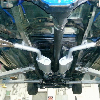@QUIXO777 Congratulations, you revived a thread that sat untouched for 16 years! That's the oldest revival I've ever seen. You also made an other world record, you actually got a good conversation going under it. Almost went for three records - nobody mentioning the ancient thread revival. 2 out of 3 ain't bad!
Moving air isn't cooler or warmer than stationary air, but the movement or circulation helps to equalize the temperature between existing hot air and existing cold air, because the heat transfers to the cooler air. This heat transfer still occurs even when the air is static, but the process takes much longer, because the hotter air isn't exposed to as much colder air to which it would dissipate heat.
On the other side of the coin, if your thermometer is in a cool place and you turn on a fan to blow air across the thermometer, chances are the thermometer will read higher after the fan is on, because the air circulation just helps to equalize the temperature by combining existing warm air with existing cooler air. Ever feel a warm breeze? Hot moving air combines with the cooler air that you're standing in, thereby increasing your local temperature. This concept is applied by electric space heaters with integrated fans; the movement helps to transfer the heat to the cooler air more efficiently, warming a room faster than that same amount of heat energy would, if it had no fan to disturb the static air.
Movement in the air can cause it to become much warmer. In fact, moving air inherently causes friction, thereby increasing its temperature - hence, why meteors, satellites, and space shuttles become extremely hot when moving into the atmosphere at high speed.
But in all seriousness, to all who have contributed, the restrictions improving efficiency is the reason you don't put a 4" exhaust pipe on every car. Depending on engine bore, stroke, and RPM's at any given time, a smaller exhaust pipe can provide better performance - the air doesn't care where the pipe is on the car, intake, exhaust, radiator, air conditioner, body panels, it's all still air. Physics rule, I wonder if when God created the heavens and the earth, if he figured we'd use air for this kind of stuff. xD












